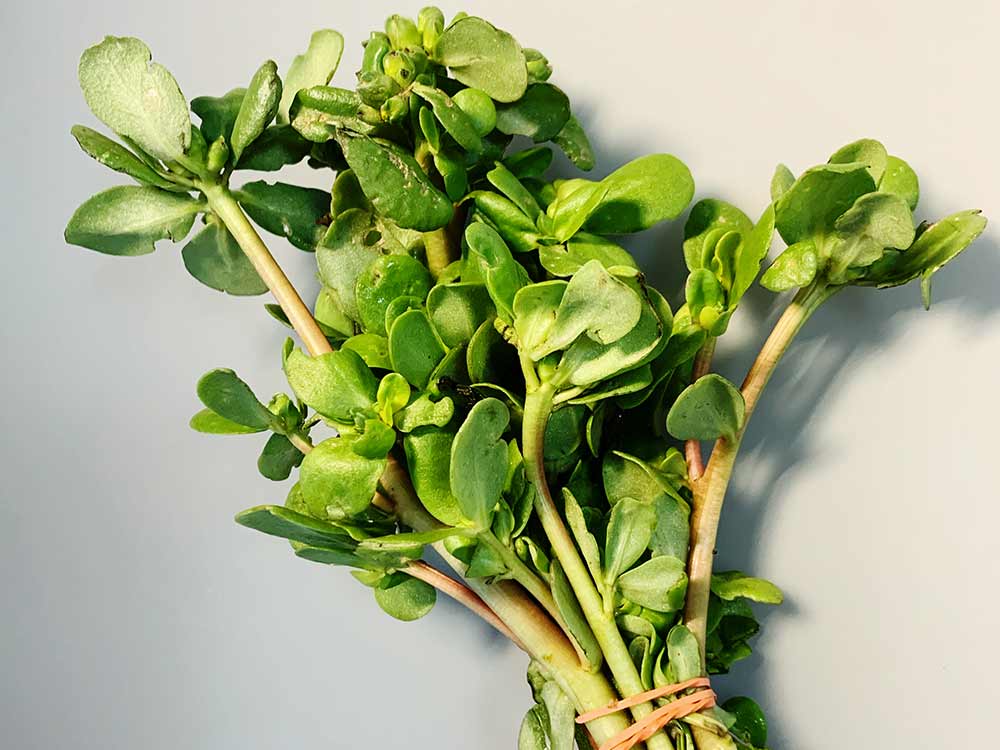PURSLANE
Some people consider purslane to be a weedy pest—but those people probably haven’t tasted it. It grows all over, including in Central Park (though laced with pesticides). But it’s far from a pest—Michael Pollan says it’s one of the most nutritious plants on earth. The fleshy succulent leaves have a lemony, slightly sour, and spicy taste and can be eaten raw or cooked. They are a great addition to salads. Purslane is a member of the Portulaca family, which includes ornamental four-o’clocks. The variety that Stoneledge Farm grows for our shares differs from the wild varieties and grows tall rather than sprawling on the ground.
Varieties in Your Share

Cultivated green-leaf variety
Storing: Store purslane in a plastic bag with holes in it for ventilation. Place it in the fridge as soon as you can and check it every few days to look for, and discard, brown leaves. Don’t wash it or remove the leaves from the stems until you’re ready to use it. It will last a week or longer in the fridge, but loses nutrients as it ages.
Preserving: The best way to preserve purslane is by pickling, which enhances its flavor; you’ll find a recipe below. Purslane doesn’t freeze well—it loses its fleshy texture and some of its flavor. If you do freeze it, steam it for a minute first, then let it drain on paper towels. Wrap it tightly in a plastic bag before freezing.
Purslane is popular in cuisines all over the world, including Greece, Mexico (where it’s called verdolagas), India, South Africa, and Turkey. Although in America we commonly use it in salads, it can also be steamed or stir-fried and used in omelettes, and dips. Purslane leaves are often added to soups and stews, adding flavor and nutrition as well as compounds that thicken them.
Purslane leaves can be the base of any salad; it pairs well with yogurt and cheese, especially feta, and pretty much any fruit, from peaches to apples to watermelon. Cooked with olive oil and garlic—and enhanced with yogurt or cream—it’s a tasty dressing for fish, poultry or meat, or a nutritious side dish on its own.
Here are some salad combinations, but let your imagination and the contents of your refrigerator lead you to others:
- Purslane with peaches and feta, with a balsamic vinaigrette
- Purslane with roasted squash and parsnips, with a sesame oil dressing
- Purslane with grilled vegetables and buttermilk dressing
- Purslane with bacon, shallots, and diced peppers, with a simple vinaigrette
- Purslane with diced tomatoes and cucumbers, with a blue cheese dressing
Strip the leaves from the stems; the stems are tough and don’t work in most recipes (though they can be pickled [link to pickled purslane stems page]). Hold the stem in one hand and run your other hand down the stem—the leaves should snap off easily.
Purslane’s slightly slicky leaves attract dirt. Put the leaves in a colander and spray them under a strong stream of water until they are squeaky clean. Or you can put them in a bowl with about a teaspoon of white distilled vinegar and swish them around, then rinse completely.
Purslane can be steamed, sautéed in oil or butter, or microwaved. In each case, keep the cooking time brief—no more than two minutes for steaming or sautéing, 30 seconds for the microwave. If you’re adding it to a soup or stew, add it during the last fifteen minutes of cooking time.
RECIPES
MISC
According to Dr. Andrew Weil, purslane “really packs a nutritional punch, with the highest levels of omega-3 fatty acids of any green plant. It is also a natural source of melatonin, and is said to have seven times the beta-carotene of carrots and six times more vitamin E than spinach. Purslane also provides vitamin A and vitamin C, and B-complex vitamins, plus the minerals iron, magnesium, calcium, potassium and manganese.
There are two basic kinds of purslane, wild and cultivated. The wild variety, a.k.a. common purslane, grows close to the ground and is a prolific, invasive weed. The cultivated green-leaf variety—which is what we get in our shares—has been bred to grow upright, which makes it easier to control and to harvest. Some cooks prefer the taste and texture of the wild variety. There is also a cultivated variety called ‘golden purslane’ that is a brighter green but is otherwise very similar to the one we get.
Purslane is not a picky plant. It grows in partial to full sun and needs some, but not a lot of, water. The main problem that farmers have with purslane is making it not grow—even the cultivated variety sprawls into rows where it is not wanted; an unchecked outbreak of purslane can take down a patch of squash or tomatoes.
Purslane can grow any time that the ground is not frozen, but it is usually harvested in mid to late spring.
No one is sure where purslane first sprang up—probably in Central or Eastern Asia or Europe—but it has grown wild for over 2,000 years in many places and there is evidence that it has also appeared in Africa, Australia, and Latin America. Farmers in ancient Egypt, Rome, and Greece learned to cultivate it. By the thirteenth century, it was a staple crop throughout Europe. Settlers brought it to the Western hemisphere and it was first mentioned in botanical literature in Massachusetts in 1672.
In China, it is called Ma Chi Xian and has been used in traditional Chinese medicine to clear heat from the body. It was known as a healing plant in ancient Greece as well; Pliny the Elder wrote that it could expel all evil.
Purslane’s tartness comes from malic and oxalic acid.
Purslane has the rare ability to vary its method of photosynthesis depending on climate conditions—it can switch from C4 to CAM pathways—which is one of the reasons it survives so easily throughout the globe.
CONTRIBUTORS


